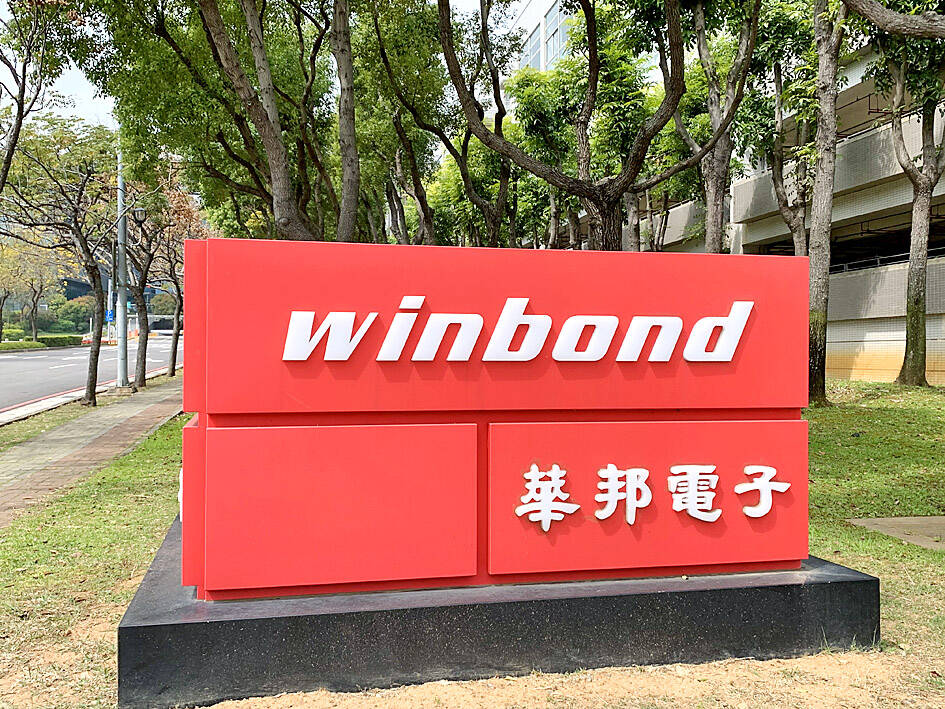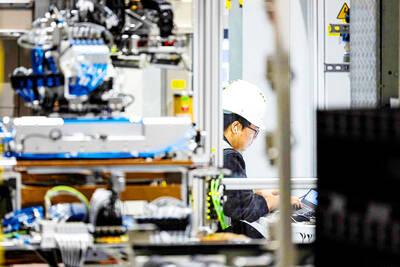Memorychip maker Winbond Electronics Corp (華邦電) yesterday said that this quarter would be its worst of the year in terms of average selling prices and factory utilization as customers signaled a pickup in demand for chips used in PCs and TVs amid falling inventory.
The Hsinchu-based chipmaker said it expects severe price cuts this quarter, with prices to remain at those levels throughout the year as oversupply and inventory corrections ease.
China’s reopening is expected to boost production there and spur a rebound in consumer spending in the world’s second-largest economy, Winbond said.

Photo: Grace Hung, Taipei Times
The growth spillover effect is expected to lift the global economy, it said.
“We expect the first quarter will be the bottom in terms of price erosion,” Winbond president James Chen (陳沛銘) told an online investors’ conference. “Oversupply is fading this year, with a marked improvement expected in the second half.”
“After strong inventory digestion efforts in the fourth quarter [last year] and the first quarter, we believe that inventory at PC vendors has dropped to quite a low level,” Chen said. “Customers told us the first quarter will be the bottom, followed by a gradual recovery in the second and third quarters.”
However, demand in the consumer electronics and networking segments remains vague, Winbond said.
People are still cautious about spending on non-essential items as retail prices remain high and central banks are on the course to hike interest rates further, although at a milder pace, it said.
As a result, Winbond does not expect a quick and significant improvement in its factory utilization this year.
Computer chips contributed 24 percent of the company’s memory chip revenue last year. The communications and consumer electronics segments made up 29 percent and 20 percent respectively. Devices for vehicles and industrial settings accounted for the remaining 27 percent.
In the final quarter of last year, Winbond’s memory revenue sank 18 percent sequentially and 39 percent annually to NT$9.4 billion (US$309.17 million).
As customers still have sufficient chips for production in the short term, Winbond expects its equipment loading rate to rise gradually after hitting the bottom this month.
Lower factory utilization took a toll on gross margin in the company’s memory business last quarter, when it was 33 percent. It was 48 percent in the third quarter and 47 percent in the fourth quarter of 2021.
However, the industrial slump did not deter Winbond from making technology upgrades and expanding capacity.
The memorychip maker said its new manufacturing factory in Kaohsiung entered volume production last month, using the new 25-nanometer technology to make DRAM chips.
Winbond aims to further its technology migration to 20-nanometers starting this summer.
The chipmaker also plans to boost the monthly capacity of the Kaohsiung plant to an economic scale of 14,000 wafers in the first quarter of next year, from 10,500 wafers, to improve costs.
Winbond expects the new plant to bring strong growth momentum in the following years as stronger technological capabilities and greater capacity allow it to broaden product lineups and to have greater flexibility in product strategy adjustments during downturns.
With the Kaohsiung plant entering production, Winbond expects this year’s depreciation and amortization costs to grow from NT$9.55 billion last year.
Capital spending on its memory business would drop sharply to about NT$12.1 billion, compared with NT$40.8 billion last year, it said.

CHIP RACE: Three years of overbroad export controls drove foreign competitors to pursue their own AI chips, and ‘cost US taxpayers billions of dollars,’ Nvidia said China has figured out the US strategy for allowing it to buy Nvidia Corp’s H200s and is rejecting the artificial intelligence (AI) chip in favor of domestically developed semiconductors, White House AI adviser David Sacks said, citing news reports. US President Donald Trump on Monday said that he would allow shipments of Nvidia’s H200 chips to China, part of an administration effort backed by Sacks to challenge Chinese tech champions such as Huawei Technologies Co (華為) by bringing US competition to their home market. On Friday, Sacks signaled that he was uncertain about whether that approach would work. “They’re rejecting our chips,” Sacks

NATIONAL SECURITY: Intel’s testing of ACM tools despite US government control ‘highlights egregious gaps in US technology protection policies,’ a former official said Chipmaker Intel Corp has tested chipmaking tools this year from a toolmaker with deep roots in China and two overseas units that were targeted by US sanctions, according to two sources with direct knowledge of the matter. Intel, which fended off calls for its CEO’s resignation from US President Donald Trump in August over his alleged ties to China, got the tools from ACM Research Inc, a Fremont, California-based producer of chipmaking equipment. Two of ACM’s units, based in Shanghai and South Korea, were among a number of firms barred last year from receiving US technology over claims they have

It is challenging to build infrastructure in much of Europe. Constrained budgets and polarized politics tend to undermine long-term projects, forcing officials to react to emergencies rather than plan for the future. Not in Austria. Today, the country is to officially open its Koralmbahn tunnel, the 5.9 billion euro (US$6.9 billion) centerpiece of a groundbreaking new railway that will eventually run from Poland’s Baltic coast to the Adriatic Sea, transforming travel within Austria and positioning the Alpine nation at the forefront of logistics in Europe. “It is Austria’s biggest socio-economic experiment in over a century,” said Eric Kirschner, an economist at Graz-based Joanneum

France is developing domestic production of electric vehicle (EV) batteries with an eye on industrial independence, but Asian experts are proving key in launching operations. In the Verkor factory outside the northern city of Dunkirk, which was inaugurated on Thursday, foreign specialists, notably from South Korea and Malaysia, are training the local staff. Verkor is the third battery gigafactory to open in northern France in a region that has become known as “Battery Valley.” At the Automotive Energy Supply Corp (AESC) factory near the city of Douai, where production has been under way for several months, Chinese engineers and technicians supervise French recruits. “They